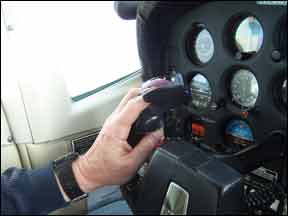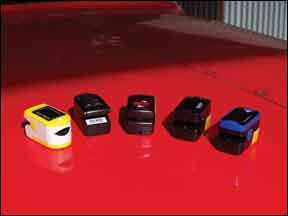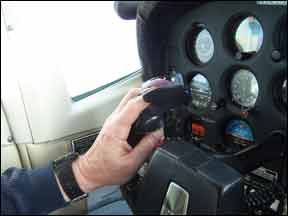Ever since the price of personal pulse oximeters dropped out of the stratosphere, we’ve owned one because it is a fast and easy way check to see if we are at risk of doing something foolish because the lungs aren’t delivering enough oxygen to the brain. Now that the selection of pulse oximeters is confusingly large, with prices from about $25 to over $200, we decided to examine a cross section.

We found that the lowest priced units worked pretty well, the others under $100 weren’t necessarily much better, and the most expensive was worth the money if you are going to be using it frequently, want a warranty and may subject it to a rough environment.
How They Work
A pulse oximeter shines light through the blood vessels of a fingertip and uses the color of the red blood cells to determine the percentage of blood oxygen saturation. For a “normal” person, the percentage, at sea level, is usually between 95 and 100. Without supplemental oxygen, the range drops steadily with altitude. For example, it is usually 70-75 percent at 20,000 feet.
Why Bother?
We learned in pilot school that a shortage of oxygen to the brain, hypoxia, causes progressively worse cognitive impairment while simultaneously convincing the brain owner that all is wonderful. FAR 91.211 gives the rules for supplemental oxygen use, however, it came into being before the advent of pulse oximetry and the recognition that one size doesn’t fit all when it comes to protection against hypoxia. We interviewed four physicians and found that none of them felt the FARs were adequate to protect a pilot against the dangers of hypoxia.

A pilot can legally climb to 13,000 feet and fly there for 30 minutes without supplemental oxygen, although his or her blood oxygen saturation at that altitude will be between 83 and 88 percent.
Dr. Bruce Chien of Peoria, Illinois, pointed out that most hospitals will not accept an “informed consent” from a patient that has a saturation below 90 percent—sobering thought.
Dr. Brent Blue of Aeromedix has published guidelines that recommend use of supplemental oxygen to avoid physical and cognitive impairment when a person’s blood oxygen saturation percentage drops 10 percentage points below what it is at the person’s home altitude. He also recommends that a person is less likely to suffer less fatigue if supplemental oxygen is started when the percentage is five points below what it is at home.
In our opinion, the use of Dr. Blue’s guidelines, more conservative than the FARs, will allow the pulse oximeter-using pilot to make an informed decision as to safe altitudes to fly if supplemental oxygen is not available and when to start using it when it is.
What’s Out There?
We went through some aviation supply catalogues and arranged to evaluate three pulse oximeters targeted at pilots. We also ordered one from Amazon, as it was the cheapest we could find and threw in one that we had had been using for two years.
We based our evaluation on speed of startup, ease of reading the screen, accuracy, durability and warranty. It turned out that startup speed was a dead heat; all of the units required six to seven seconds.
Only one unit, the 9590 Onyx Vantage, was a “medical unit,” meeting accuracy and durability requirements for use in hospitals—and requiring a prescription to buy, which the seller will arrange as part of the purchase price. We used it as our control when checking the units on volunteers on a flight, with supplemental oxygen, to 17,500 feet. All units were within two percentage points of the Onyx at all altitudes.
For $24.95 plus shipping, we received a Contec CMS50DL from Amazon. The display on the Chinese-built unit was adequate, but hard to read in direct sunlight and with only one orientation, finger pointed at the person reading it. It has no warranty.
We have owned and used a Contec CMS50D for two years, and found it offered for sale on the Internet recently for $32.00 plus shipping. We like the display, as simply pushing the power button changes its orientation and size to the user’s preference. On one test at 17,500 feet, it took some time to get a reading on one of our subjects. We were advised that this is not unusual for persons with poor circulation. It was the only unit that displayed any reluctance to give a reading and then only once. It comes with no warranty. We have dropped the unit a few times and it has survived thus far.
Sporty’s offers the Oxi-Plus Pro, a U.S.-made unit for $49.95, recently marked down from $99.95. The adjustable brightness display is easy to read, even in direct sunlight. The orientation is rotated 90 degrees each time the power switch is pressed after initial start up. The unit comes with a soft carrying case, a nice to have but not essential item, in our view. No warranty is offered.
The Fingertip Pulse Oximeter from Aircraft Spruce and Specialty is a Chinese-made unit priced at $89.95. No warranty is offered. We did not like its display, as the pulse rate and blood oxygen saturation percentage could only be read with the finger pointed directly toward or away from the user—the power switch changes the orientation 180 degrees each time it’s pressed after startup—however, the pulse and saturation labels were turned 90 degrees to the actual numbers, making it difficult to quickly tell which number was which. Even though the display was moderately easy to read in sunlight, the potentially confusing presentation caused us to not care for the unit.
Aeromedix offers a pulse oximeter that uses components and technology that make it a medical device rather than a consumer product, thus it requires a prescription—which Aeromedix arranges when you order the 9590 Onyx Vantage. This U.S.-made device from Nonin Medical, Inc., a company that specializes in medical monitoring equipment, is priced at $179.00, down from $225.00. It is the only oximeter we examined that came with a warranty, a whopping four years. The unit is slightly more compact than the others and feels more robust. We observed a video in which one was dropped on to a tile floor 50 times from a height of about 30 inches and functioned normally. The display was clear and easy to read in sunlight, although it set up such that the finger had to be pointed at the observer.
Conclusions
If accuracy, a warranty and durability matter, we recommend going with an oximeter that meets the standards of a medical device and purchasing the 9590 Onyx Vantage. At the other end of the scale, because all of the oximeters we tested were within two percentage points of the medical unit, and because we feel strongly that having and using a pulse oximeter can improve decisions relating to safety of flight, we see nothing wrong with going with an inexpensive unit such as the Contec CMS50D. We say this with the warning that it is a consumer, not a medical, device and may or may not last any length of time, but for $32 it gives valuable information and if it does fail, it doesn’t cost that much to replace.


